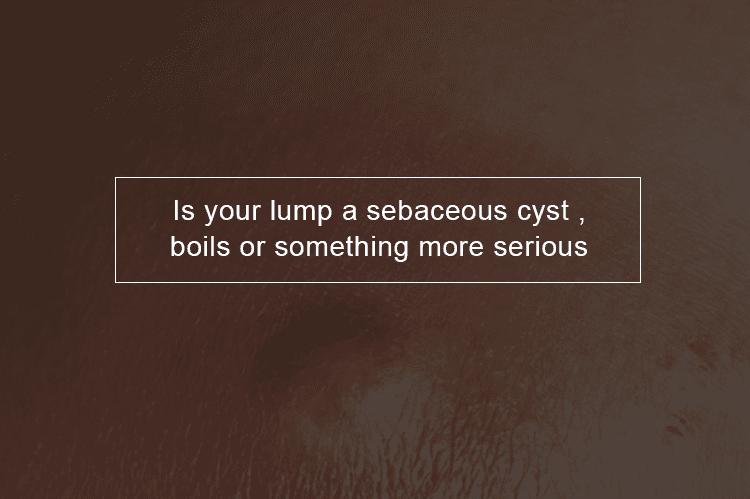
Both cyst and boils can make lumps to develop under your skin. The main difference is that cysts, are not painful and feel smooth when touched, while a boil is caused by a bacterial or fungal infection. A boil is a painful, red skin bump which has a general feeling of malaise. Cysts are not contagious; however, boils can spread bacteria or fungi on contact.
You could have noticed at one point, a small bump under your skin, possibly behind your years, on your chest, shoulders, in your nose, or the back. And then you wondered is it a cyst or a boil? Generally, both cyst and boils can cause lumps to form under your skin. They usually have the same appearance, but their causes, symptoms, and treatment are different. In this post, we will provide you with a rundown of boils and cysts.
Is a cyst and a boil the same thing?
What are a sebaceous cyst and boils?
A cyst is a small fluid- filled lump which can form in or on a human’s body. It is easy to mistake a cyst for boils as they have similar symptoms. Generally, there are various types of cyst. The most prevailing are epidermal, trichilemmal and milia, which could all be problematic if infected.
For the epidermal and trichilemmal cyst, they look the same, but trichilemmal usually form on a person’s scalp. While milia cysts mostly occur on the face, and especially the eyes. Milia are smaller in size compared to epidermal and trichilemmal. Fortunately, all the cysts are benign, meaning they are noncancerous.
A boil is an ordinary condition which may start as a small lump and later becomes red. Unlike cysts, boils tend to be larger and slightly painful. Moreover, a boil can make someone feel weak and tired, especially if one develops a fever as a result of bacteria infection-this is unlikely in the cyst.
How do you tell the difference between a boil and a cyst?
In Spite of their same appearances, there are critical differences between boils and cyst. To differentiate the two conditions clearly, one must be able to tell their symptoms.
What are the symptoms of boils in the human body?
Usually, a boil starts as a hard, red, painful lump often almost half an inch in size. Over a few days, the lump then becomes softer, larger and more painful. Later, a pocket of yellow pus forms on the top of the boil. While you may have a boil which looks like many others- painful, red, swollen and may be filled with pus- the following are symptoms of a severe boil infection, which could be dangerous.
- If your boils keep coming back and won’t heal, you might want to see a doctor
- If you develop fever and start feeling weak and tired, visit a doctor as you are having severe boils infection
- Lymph nodes become swollen signifies serious boil infection
- If you develop more boils around the original boil, then the condition is getting serious
- You may also want to call a doctor if the skin around the boil becomes red, painful, warm and swollen
- If your boil is crusty and bleeds easily check with your doctor to prevent a more severe infection
What are sebaceous cyst the symptoms?
If you have a cyst that doesn’t have inflammation, you may not experience any associated symptoms; however, if the cyst becomes inflamed, it can become red, swollen and painful just like a boil. Usually, a cyst ruptures on exposure to pressure for example if a person falls on it. In the case of the cyst burst, a person can notice yellow, unpleasant-smelling pus.
Boils tend to form on a person neck or face. But can also appear in the armpits, around the groin including gentiles, on the thighs and on the bottom. There is no definite reason why people develop a cyst, but usually, it appears after someone has sustained injuries to their skin. Cysts can also form when skin cells multiply faster. Cyst lumps are linked to sun damage on a person’s skin, and some treatments can increase the probability of a cyst forming.
What are the differences between boils and cyst treatment?
The treatment of cysts and boils varies by their location on the body. While some boils and cysts may not need any treatment at all, others especially those causing pain and discomfort require to be removed. Usually, cysts involve minor surgery to remove it. Fortunately, the doctor gives the individual anesthetic before removing the cyst. Thus prevent scarring.
Boils are often treated at home. But if a boil is severe or keeps reoccurring and does not heal, a doctor could will extract a sample of the pus in the boil, send it to a laboratory and determine which bacterial infection has caused it. Then the doctor can prescribe a more effective antibiotic for the infection.
How do you bring a boil to a head overnight?
Home remedies for sebaceous cysts and boils
Before discussing the various home remedies options for sebaceous cysts and boils, it is essential to go through the precautionary points.
1. Never try to remove a pop or a cyst at home, as this may increase the probability of infection. Additionally, poping does not assure the cyst or boil will end completely.
2. The remedies are not 100% proven to remove the cysts or boil completely; however, they are scientifically suggested to aid.
3. Follow the procedures correctly, so as not to increase the chance of boil or cyst infection
You need to see a doctor if symptoms of the boils or cyst persist even after trying the home remedies
The first step for boils and cysts home remedies is always to keep them clean. Use a simple soap and water, rinse the boil well and air-dry, especially if the cyst or boil is infected. Then you can proceed to use any of the methods outlined below.
How do you apply heat to treat boils and sebaceous cysts at home?
Heating increases the flow and the healing process. It brings more white blood cells to the area thus fighting the infection. Apply a warm compress to the area for about twenty minutes a time. Repeat this three to four times in a day, every day, till the boil disappears.
How to treat boils and sebaceous cysts at home with turmeric powder?
Turmeric is popular for its anti-inflammatory effects, which can aid in healing a boil and removing it faster. In this case, you opt to ingest the turmeric powder or use it topically. To ingest it, boil a teaspoon of the powder in water or milk, and drink it three times daily once it has cooled. To use it topically make a paste by mixing turmeric with water and ginger. Apply it to boil at least twice a day.
How to use Epsom salt as a home remedy for boils?
Epsom salt is an effective treatment for boils when put in warm water. Soak a compress in it and apply the compress on the affected area twenty minutes at a time. You may also soak the infected area. Repeat the remedy three times every day until the boil disappears. Epsom can drain out pus thus making the boil to dry.
What are over the counter antibiotic ointment to treat boils at home?
Fortunately, you can use over the counter antibiotic ointment to treat a boil at home. Most of the ointments are act fast and are soothing. The most popular over the counter antibiotic ointment for boils or cysts is Neosporin tube. It helps to prevent the infection from spreading. Smear the ointment at least twice a day on the boil and the affected area, till it is gone.
How to treat boils and sebaceous cyst at home using herbs?
A blend of dandelion and viola herbs placed in an herbal bag and soaked in a teacup for about forty-five minutes and be squeezed lightly and applied directly on the boil or cyst for a few minutes. After this, drink tea three or four times a day.
Oils, creams, and liquids used to treat boils and sebaceous cysts at home
There are various oils, creams and liquids you can apply while at home to treat boils and cysts. Some of them you have to secure with a plastic tape for a few hours overnight to prevent spreading boils and cyst germs.
The following are the most popular oils, creams, and liquids for cysts and boils remedies.
Tea tree oil as a home remedy for boils and cysts
Tea tree oil has strong antiseptic effects which can be used to treat the bacteria causing the boil or cyst. However, it should not be applied directly to the skin as it has a burning effect. To treat a boil, mix five drops of tea tree oil with a teaspoonful of coconut or olive oil. Put a cotton swab and apply the mixture on the boil. The application should be done at least two times in a day till the boil disappear completely.
Using castor oil to treat boils and cysts at home
Castor oil is popular as an anti-inflammatory agent cures boil. To treat a boil with castor oil, apply a small amount of castor oil directly to the boil two- three times in a day until the boil is gone completely.
Treat boils at home with Neem oil
Commonly known as Indian lilac, Neem oil, has strong antiseptic properties which can cure skin infection including boils. To treat a boil at home with Neem oil, apply the oil directly to the boil, three to four times a day. Wash your hands before and after application. Other home remedies to remove a cyst or boils include; bee pollen, a few drops of potassium iodide applied three to four times a day and Aloe vera gel.
Boil healing stages
If you follow any of the above method, the boil will come to a head in a few days. In about a week of the home treatment, the boil could open on its own if it does not contact a doctor. If you are lucky and the boil opens on its own, wash the area and dress it with a sterile bandage. This will prevent the infection from spreading.
At this stage, pus will start draining from your boil. So you have to clean your hands always and throw away the used bandages and towels.For the next days continue cleaning and draining the wound. Eventually, the boil will be fully drained. Then clean, dry and bandage the area until it is completely healed.Be patient with the boil healing stages and avoid squeezing open a boil yourself. It should it on its own.
What does a boil look like?
Boil healing stages
A boil is similar to an acne pimple on steroids. It is hard to distinguish a boil from a pimple in the beginning especially to the ‘untrained eye.’ As discussed earlier a boil starts as a firm, red, painful lump under the skin surface. So how else can you tell it is a boil?
1. If you got a lump on your groin, armpits, thigh or maybe on your breast, it is probably a boil. Pimples and cysts rarely form on these body parts.
2. How big is your lump? If your lump is larger than a nickel, then you are dealing with a boil. Boils start small and become larger with time.
What causes boils?
Boils are caused by staph bacteria which most healthy people carry on their skin or in their noses without a problem. When a scrape cuts the skin, the bacteria may enter the hair follicle and break as an infection. Boils which are linked to acne are as a result of clogged pores which become infected.
Are boils contagious?
Boils are not really contagious; however, the bacteria causing it can easily to spread through skin-to-skin contact. The bacterias usually do not infect unless they find a break in. To avoid spreading do not share towels, beddings, sports gear or clothes with infected persons. Moreover, avoid touching the boil and keep it covered. Also, wash your hands frequently to prevent spreading the bacteria.
Who gets infected with boils?
Generally, boils can form on any human body. However, the risk increases if:
- An individual is in close contact with an infected person
- If an individual has acne or other skin infections
- Diabetic persons have a high risk of boils infection
- If you have a weak immune system, boils can easily develop on your body
How to prevent boils and sebaceous cysts?
As bacterias are everywhere- on the environment, on people’s skin, the following practices can help you defend yourself against boils.Clean your hands regularly and use an alcohol-based sanitizer to defend yourself against boils and cysts bacteria. Clean your cuts and other wounds carefully to prevent boils and cysts bacteria break-in. You might also want to keep your wounds covered to defend yourself against boils and cysts bacteria. Do not share towels and sheets razors, also wash towels and sheets or anything which is in contact with an infected area with boils and cysts in hot water. Throw away any wound dressing to prevent the spread of boils and cysts.




